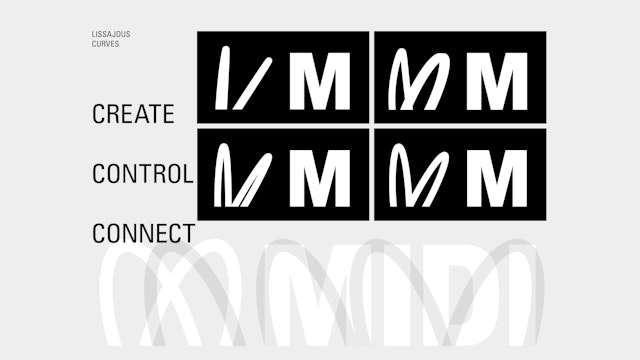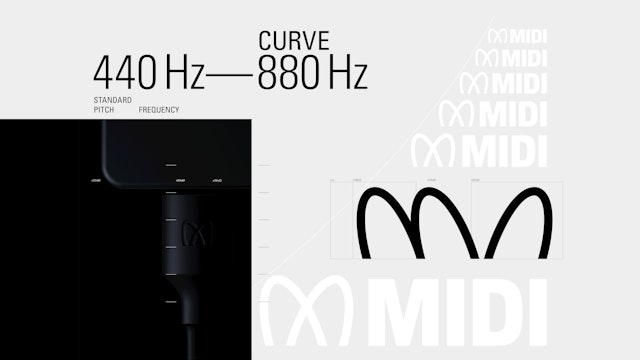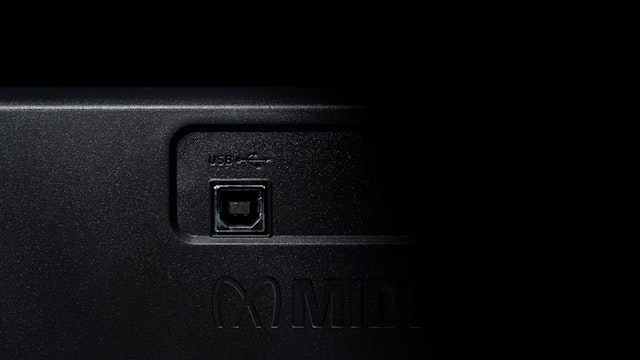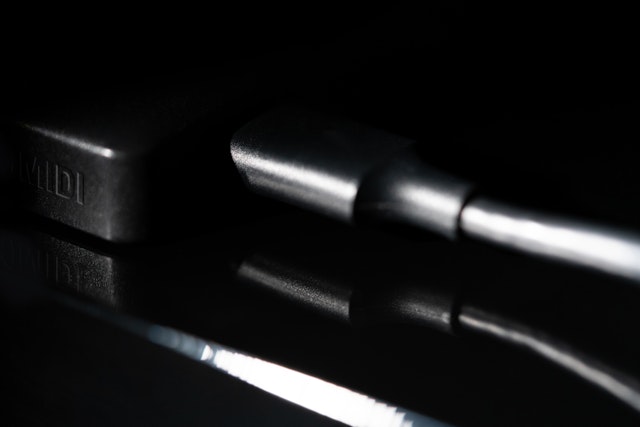
MIDI, an acronym for Musical Instrument Digital Interface, is instantly recognisable to anyone who makes, edits or plays music, and is used every day around the world by musicians, DJs, producers, educators, artists and hobbyists to create, perform, learn and share music and artistic works.

The wordmarque design references the shape of Lissajous curves, which are graphs of a system of parametric equations used to describe complex harmonic motion. The finalised design represents a modulation shape between 440 Hz – 880 Hz globally recognised as a tone for tuning instruments.

Taking centre stage in the identity, the trademark is inspired by musical forms, such as the Stuttgart pitch, which is an oscilloscope reading of sine waves at a frequency of 440 Hz. The Stuttgart pitch serves as a tuning standard for the musical note of A above middle C, or A4 in scientific pitch notation. A440 has been widely adopted as a reference frequency to calibrate acoustic equipment and to tune various musical instruments.
The sonic logo complements the wordmarque design, creating a mirror between sound and vision. The pitch starts out at 440 Hz and then rises to 880 Hz, with subtle wave shape and stereo modulation. There is an anticipatory feeling to the sonic identity, similar to that of an orchestra tuning to 440 Hz or Strauss’ ‘Also Sprach Zarathustra’. The simplicity and power of these pitches can create a Pavlovian response. Minimal orchestral strings complement the sine waves.




The binary of the heard and unheard

Sound is sentimental and can be imagined even in the absence of audible clues – a synesthesia of sorts that visualizes sound and vice versa. Unheard outputs such as imagery and motion give way to soundscapes trained by synaptic communication in our brains that create memories.
We may only have an image of weighted balls hurtling down a polyurethane-finished runway and colliding with one another, yet our minds have already formed an innate archive of sounds. We might catch a muted and distorted reflection of the Autobahn in a high-rise with cars zipping by. Notwithstanding the absence of sound, we can still mentally piece together this moment’s audible fingerprint.
Sound is omnipresent, even in the calmest calm of aerial photography and cloud gazing from the window of an airplane cruising 35,000 feet over the skies of Mongolia.
Pentagram was commissioned to head up MIDI’s brand identity design to maximise exposure and adoption of MIDI 2.0. Taking centre stage in the identity, the trademark is inspired by musical forms, such as the Stuttgart pitch, which is an oscilloscope reading of sine waves at a frequency of 440 Hz. The Stuttgart pitch serves as a tuning standard for the musical note of A above middle C, or A4 in scientific pitch notation. A440 has been widely adopted as a reference frequency to calibrate acoustic equipment and to tune various musical instruments.
The wordmarque design also references the shape of Lissajous curves, which are graphs of a system of parametric equations used to describe complex harmonic motion. The finalised design represents a modulation shape between 440 Hz – 880 Hz which is globally recognised as a tone for tuning instruments.
The sonic logo complements the wordmarque design, creating a mirror between sound and vision. The pitch starts out at 440 Hz and then rises to 880 Hz, with subtle wave shape and stereo modulation. There is an anticipatory feeling to the sonic identity, similar to that of an orchestra tuning to 440 Hz or Strauss’ ‘Also Sprach Zarathustra’. The simplicity and power of these pitches can create a Pavlovian response. Minimal orchestral strings complement the sine waves.
MIDI’s new identity feeds on the interplay between the visual and sonic, creating a suitably iconic logo for the next generation of music makers and music lovers. The MIDI 2.0 visual campaign is based on the heard and unheard, a synesthesia of sorts that visualises sound and vice versa. Sound is sentimental and can be imagined even in the absence of audible clues with unheard outputs such as imagery and motion giving way to soundscapes trained by synaptic communication in our brains that create memories.
MIDI is instantly recognisable to anyone who makes, edits or plays music, and is used every day around the world by musicians, DJs, producers, educators, artists and hobbyists to create, perform, learn and share music and artistic works. Since 1981, MIDI has dramatically changed the way musical instruments communicate, connecting electronic music instruments, computers and other audio devices. For the first time ever, products from different manufacturers were able to seamlessly interact with one another, stimulating computer music sequencing programmes to take form and become the backbone of modern day music-making.
The MIDI Association released the first makeover of the product in 2020 and branded it as MIDI 2.0, which was the most significant update in 35 years. MIDI 2.0 is a future-proof upgrade which introduces novel features and added functionality as MIDI’s use has grown to include computers, tablets and smartphones. One of the main attributes of MIDI 2.0 is bi-directionality, which enables MIDI 2.0 devices to communicate in both directions.
Client
The MIDI AssociationSector
- Technology
Discipline
- Brand Identity
- Motion Graphics & Film
- Typefaces
Office
- London
Partners
- Sascha Lobe
- Yuri Suzuki
Project team
- Miltos Bottis
- Rommina Dolorier
- Leo Field
- Tom Hallgren
- Shawden Sheabar
- Johannes Spitzer
- Maxwell Sterling
- Gabriel Vergara II
- Alice Lazarus
